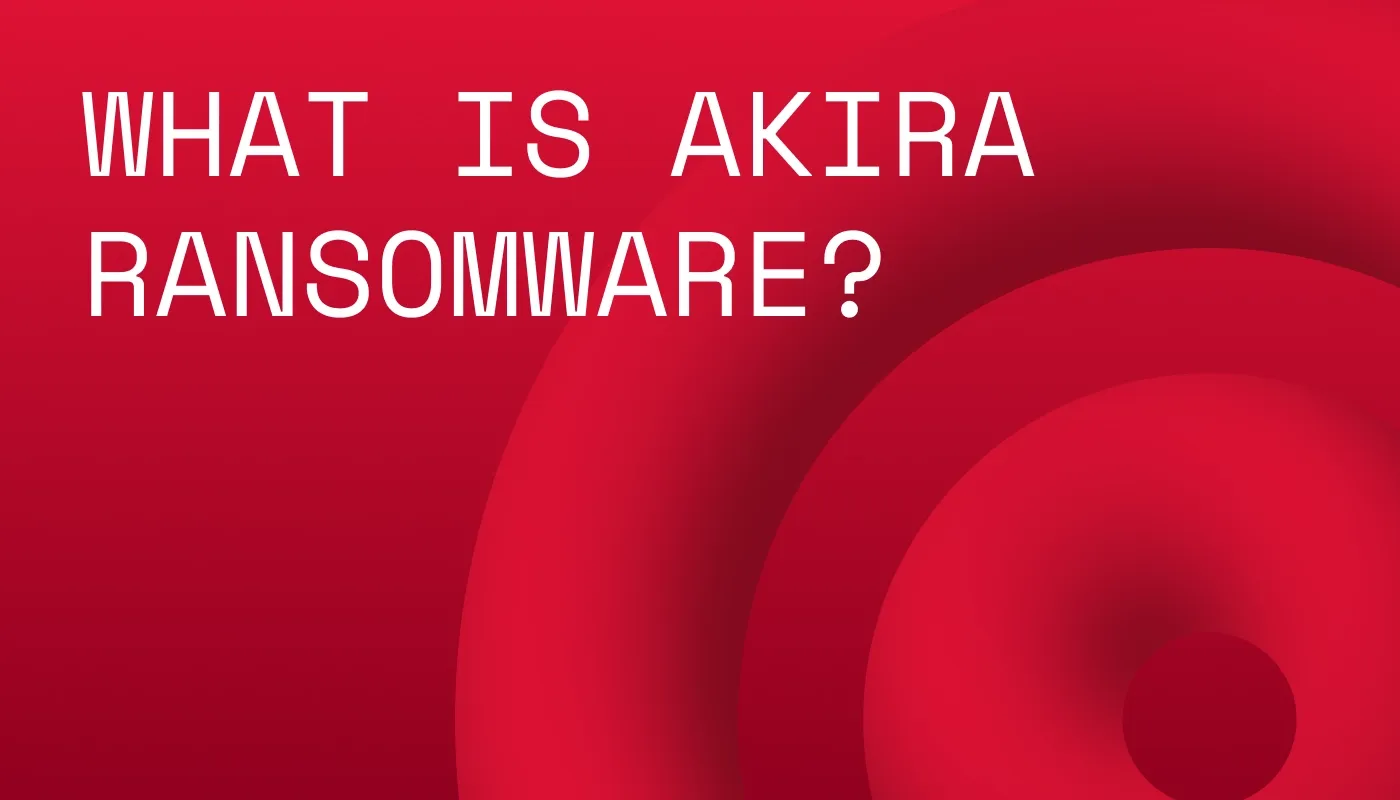Summary: Akira ransomware threatens companies of all sizes, but they can defend themselves with the right security tools and access policies.
It may be a hard pill to swallow, but ransomware isn’t becoming less of a threat to businesses. If anything, 2025 has shown that ransomware attacks are growing more sophisticated, more aggressive, and target both small companies and industry giants alike.
Sure, there’s still the familiar, run-of-the-mill ransomware that can often be avoided. But then there’s the kind unleashed by the most ruthless hacker groups, like Akira. When this one hits, things can get serious fast. In this article, we’ll break down exactly what Akira ransomware is and how you can defend your organization against it.
Key takeaways
The Akira ransomware group has extorted an estimated $42 million in ransom payments, making it one of the fastest‑growing threats today.
The group uses every available method to breach companies, including phishing, MFA vulnerabilities, leaked passwords, and unpatched systems.
Organizations can defend themselves against Akira ransomware attacks by enforcing strong access policies, backing up critical data, and monitoring the dark web.
What is Akira ransomware?
Akira is the name of a ransomware-as-a-service (RaaS) group that first appeared at the start of 2023. They deploy malware that encrypts victims’ data and demand a ransom for its decryption. On top of that, they threaten to leak the data publicly if the ransom isn’t paid. This tactic is known as double extortion, and it’s what makes Akira particularly dangerous.
Since launching, Akira has reportedly carried out over 250 high-profile ransomware attacks on organizations like BHI Energy, Nissan Australia, and Stanford University, collecting an estimated $42 million in ransom payments. With this track record, the group has become one of the most formidable ransomware threats today.
Risk to business operations
As you can imagine, an Akira ransomware attack poses a huge risk to any targeted organization. First, it can severely disrupt business operations by blocking access to critical information. The resulting downtime can be significant and lead to major financial losses.
Then the company’s reputation is also at stake. If the ransom isn’t paid and data is leaked, the business may take a serious hit to customer and partner trust, making it difficult to rebuild its name. Not to mention the compliance issues caused by a data breach, which can result in hefty fines for the organization.
And, of course, we cannot forget about the ransom itself, which can reach millions of dollars. This can force a company to lose a substantial sum with no guarantee that the data will be returned or kept private.
How Akira gains access and spreads through networks
At this point, you might be wondering: how exactly can the Akira group infiltrate a large company’s systems and networks, navigate them freely, locate valuable information, and then encrypt it? Well, here’s what a typical Akira ransomware attack looks like:
Primary methods of initial access
Akira often starts by exploiting stolen or weak passwords and poorly secured multi-factor authentication (MFA), which gives them an easy foot in the door. They also rely on phishing emails, credential stuffing, and remote access tools to trick employees into exposing their accounts. Sometimes, the attackers also take advantage of vulnerabilities in misconfigured VPNs or firewalls, sneaking in through gaps that haven’t been patched yet. Essentially, any weak link in a company’s security can become a point of entry.
Movement inside the network
Once inside, Akira doesn’t just sit quietly. They begin using system tools to move between computers, exploring the network to see what’s valuable. They work to gain administrator rights, which gives them almost unrestricted access to the company’s infrastructure. To avoid detection, they engage in what’s called defense evasion, which involves disabling backups and turning off security software wherever possible. By the time anyone notices, the attackers have all the critical assets already mapped out.
Encryption, exfiltration, and ransom demand
Before encrypting anything, Akira exfiltrates sensitive data, setting the stage for a “double extortion” threat. They then rename files with the “.akira” extension and leave a ransom note called “akira_readme.txt” in every folder. And then, they simply wait for the victim’s response. If the ransom isn’t paid, they post the stolen data on the dark web and illegal marketplaces, adding public pressure on the targeted company.
Recent Akira ransomware group activity
According to cybersecurity experts, Akira’s activity has increased in 2025 compared to previous years. In August 2025 alone, Akira claimed responsibility for 57 breaches.
In mid-to-late 2025, multiple researchers reported that the group shifted to actively exploiting SonicWall VPN and firewall flaws (SMA/Secure Mobile Access software), taking advantage of these edge-device weaknesses to gain initial access and deploy ransomware.
Recent data also shows that Akira is expanding the types of systems it targets, now including Linux servers and virtual machines, not just traditional Windows endpoints. Additionally, the group is increasing the volume of attacks and broadening its focus. Rather than concentrating solely on high-profile organizations, it is now also targeting small and medium-sized businesses.
Related articles

Joanna KrysińskaNov 12, 202512 min read

NordStellarJun 13, 202514 min read
Signs of Akira infection and ways to detect it
Discovering an Akira ransomware infection early can make all the difference. The group’s attacks often unfold quietly in the background, long before data is encrypted and ransom notes begin to appear. Knowing what to look for can help your team detect a breach before it causes serious damage.
Known indicators of compromise
Once Akira has made its move, a few telltale signs tend to show up. Files suddenly gain new extensions, often marking the start of data encryption. As mentioned, victims may also find ransom note files named “akira_readme.txt” scattered across folders, outlining the attackers’ demands. Another red flag is sudden data loss or folders that users can no longer access. If any of these signs are visible, it may be an indication that Akira is already active inside the network.
Detection techniques and monitoring
Proactive monitoring is essential to detect Akira before it fully takes hold. Endpoint protection tools that flag unexpected file changes can help uncover unauthorized encryption activity. At the same time, keeping an eye on network traffic for unusual behavior, such as large outbound transfers or communication with unknown IP addresses, can reveal potential intrusions. Reviewing VPN and login logs for suspicious or unknown users also provides insight into whether attackers have already gained remote access to your environment.
Threat intelligence integration
Akira is now one of the most dangerous cybercriminal groups, so staying ahead requires more than just reactive monitoring. Integrating Akira-specific threat intelligence solutions can help you spot new tactics or variants before they reach your systems. Security teams should also monitor the dark web for any signs of leaks involving company data. Finally, mapping detection rules to the MITRE ATT&CK framework ensures that your organization has broad and structured coverage against the techniques this group and others like it typically use.
How to defend against Akira: Mitigation strategies and best practices
Based on what we’ve covered so far, you might get the impression that once Akira targets your organization, it’s all over. That’s not the case. There are several steps your company can take to protect itself against ransomware attacks from Akira and other ransomware groups. Here are some of the most effective ones.
Strengthen your access controls
First of all, you need to make it difficult for attackers to infiltrate your digital environment. To do that, enforce multi-factor authentication across your systems and implement a strong credential policy to ensure no one on the team is using easily guessable logins. You should also review and harden your VPN and firewall configurations, disable unnecessary services, and make sure only the right people have access to sensitive systems. Network segmentation—that is, breaking the network into smaller, isolated parts—can also help limit the blast radius if an Akira attack does get through.
Keep all software up to date
While you’re working on closing off easy points of entry for cybercriminals, make sure patching systems is part of the process. Threat actors often exploit vulnerabilities in outdated software, so don’t give them the chance. Apply critical security updates as soon as possible, especially for internet-facing assets. Regular vulnerability scans and penetration tests can also help you find and fix weak spots before someone else does.
Have a solid backup of your critical data
Since ransomware attacks focus primarily on encrypting business data, you should always maintain a reliable backup of essential files. That way, unless it’s data that must remain strictly private, you can continue your operations. Keep offline, immutable backups that attackers can’t tamper with, and test your recovery process regularly to ensure it actually works. It’s also wise to isolate your backup environment using microsegmentation for an extra layer of protection.
Improve your security monitoring and threat response
The fact is that the sooner you detect an intrusion, the better your chances of stopping it. Therefore, you should deploy tools like endpoint detection and response (EDR) solutions and security information and event management (SIEM) systems for continuous monitoring. Run regular incident response drills to ensure your team knows exactly what to do when alerts start flashing.
Prepare for crisis management
If an attack does happen, you’ll need more than just technical know-how. So, develop an attack response plan that includes your legal, PR, and IT teams, and define clear steps, including how to handle ransom demands. With a solid strategy in place, your employees can respond with confidence instead of scrambling in the moment.
Educate your employees
Remember that your people are your first line of defense. If you want your team to spot phishing attempts and other ransomware tricks, you must help them learn how. Organize cybersecurity training sessions and regularly assess their knowledge. Most importantly, tell everyone to report anything that looks off, as that can stop an attack before it spreads.
What to do after an Akira attack
Despite your best efforts, Akira might still manage to launch a successful attack on your company. The group is a persistent and resourceful adversary that will exploit every possible weakness, whether it’s a simple human error or a small oversight in your MFA configuration. If that happens, you’ll need to act swiftly and decisively to contain the damage and restore control. Here are a few key steps to take if they breach your defenses.
1. Disconnect affected systems immediately: Isolate any compromised devices from the network to prevent the attack from spreading further.
2. Contact security and legal teams: Notify your internal teams so they can coordinate the response and address legal obligations.
3. Investigate how the attack began: Determine the entry point and method of attack to prevent future incidents.
4. Restore data from backups if available: Recover affected systems using clean backups that are free from compromise.
5. Report the breach if required by law: Comply with mandatory notification requirements to regulators and affected parties.
6. Update defenses to prevent repeat attacks: Strengthen security measures based on lessons learned from the incident.
How NordStellar can help
One of the most important aspects of protecting your business from Akira and other ransomware groups is knowing your actual exposure and having real-time visibility if a breach occurs. And since it’s not something you can do manually, having the right tools like NordStellar is essential.
NordStellar is a threat exposure management platform that uses dark web monitoring to detect cyber threats targeting your organization. The platform tracks numerous ransomware blogs and instantly alerts you if a mention of your company, a partner, or a supplier appears on one, helping you evaluate the impact and secure any shared sensitive data. It also identifies risks from compromised employee and consumer data and performs external vulnerability scans to uncover weaknesses in your internet-facing assets. All of this enables you to spot threats early and respond quickly, minimizing any impact on your business.
In other words, NordStellar shows you when threat actors are approaching your digital premises and provides actionable intelligence to help you stay one step ahead.

Maciej Sikora
Senior Copywriter
A man on a mission to engage audiences with creative wordplay, Maciej knows every complex idea can be broken down into simple words—and that’s his driving force. When he’s not writing, you’ll find him making music, taking a walk with his dog, or watching yet another movie.








